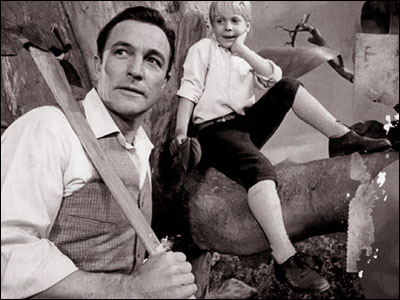Back here, we were talking about a 1967 special Hanna-Barbera produced for NBC — a retelling of the story of Jack and the Beanstalk. A new part was written in for Gene Kelly, who was also credited as director, though it's doubtful he had a lot to do with the animated characters that were combined with the live-action performers. I thought it was a pretty decent special for what it was but recognize that there are many who did not agree.
My pal Greg Ehrbar is one of the best of the many experts now writing about cartoon history. He is quite familiar with this special and he sent me this…
Master Hanna-Barbera art director and effects animator Ron Dias talked at length about Jack and the Beanstalk. In his experience, Hanna and Barbera usually began a project with very grand plans but when the money was running out, they scrambled to get it done, just as you explained.
Of course, there was nowhere near the budget for a 1967 NBC hour special compared to a 1945 MGM extravaganza like Anchors Aweigh. What frustrated Dias was that H-B used a dry "just add water" blue paint for the blue screen rather than the more expensive liquid paint, which did things like flake off on Gene Kelly's knees if he did a kneeling slide in his dancing, making them disappear.
He also said that he was not thrilled that they hired a less competent processing house to do the compositing, so that is why you can occasionally see the mattes (look for the staircase on the goose). However, he was still fond of the special, and we have to keep in mind that it was the first of its kind and very ambitious, perhaps too ambitious.
I've had the soundtrack album for years and listened to it more times than you've sent back cole slaw after you told them not to include it. I am certain that Leo DeLyon (a singer by trade) and Cliff Norton (who mostly talk sings) are doing the singing in "The Woggle-Bird Song," which by the way, was originally written for Filmation's Journey Back to Oz (which began production in 1962) by Sammy Cahn and Jimmy Van Heusen as "The Woggle-Bug Song."
Dick Beals told me that after he sang for Bobby Riha, Bobby's mother was furious when she learned that Beals took out an ad in Variety, revealing this fact (with H-B's blessing). She wanted to establish Bobby as an all-around talent who could sing, dance and act (he appeared in Disney's The One and Only, Genuine, Original Family Band the following year, mostly danced and said, "The British are coming! The British are coming!"
According to Joe Barbera's autobiography, Gene Kelly was unhappy with the final show and asked that NBC pull it from the schedule, which was impossible. It turned out to be a huge ratings and critical success (paving the way for The Adventures of Huckleberry Finn, the first TV series to combine live-action with animation unless you count Clutch Cargo). When it won an Emmy for Outstanding Children's Program, It was Kelly who received the award as the producer of Jack and the Beanstalk (Hanna and Barbera never received any award until Last of the Curlews in 1972 — even the seven Oscars they won for Tom and Jerry and the Emmy for The Huckleberry Hound Show were not given to them, but to those with the "producer" title).
When Kelly accepted the award, he did not mention Hanna and Barbera but instead said that he could not take full credit for the success because there were also a lot of "little hands" also involved. Barbera learned to deal with that because of the Hollywood's precarious effect on people's psyches (perhaps Kelly needed the recognition more than they did) and took it in stride.
Kelly later appeared in the CBS TV salute to H-B, The Happy World of Hanna-Barbera. Their animation also appeared in MGM's That's Entertainment, Part 2 co-starring Kelly and Fred Astaire, which could very well have been by Kelly's recommendation.
Thanks, Greg. (And those of you who want to check out Greg's fine writing about cartoons need only frequent — assuming you don't already — this cranny of the Cartoon Research website.
